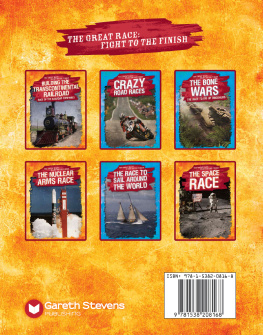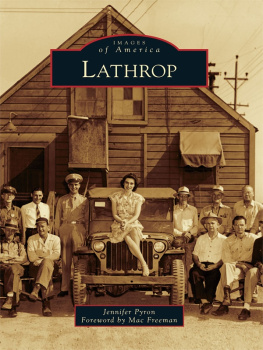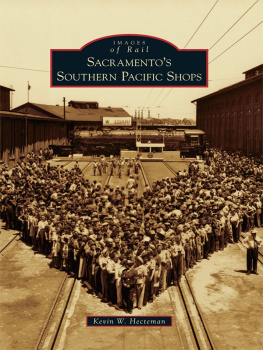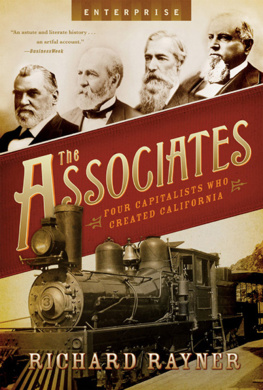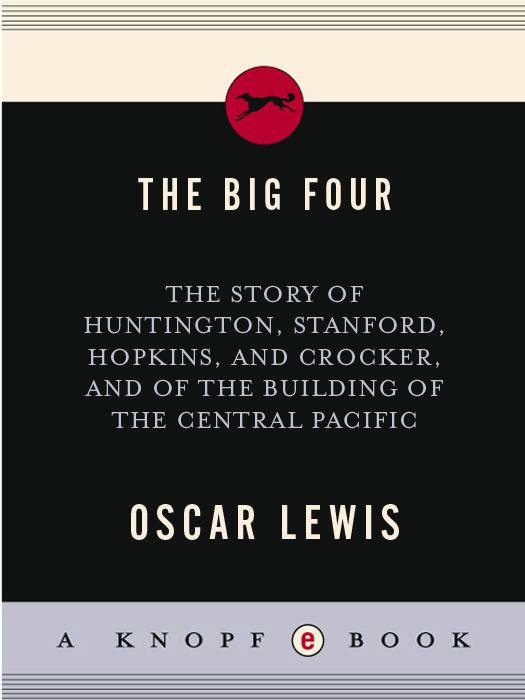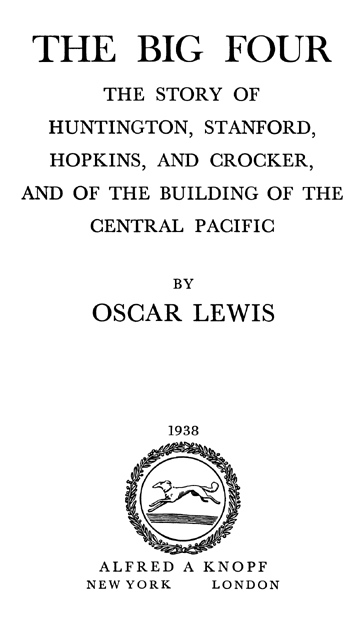CALIFORNIANA

OUTPOST OF EMPIRE
by Herbert Eugene Bolton
THE BARBARY COAST
by Herbert Asbury
LOS ANGELES
by Morrow Mayo

These are Borzoi Books,
published by A LFRED A. K NOPF
Copyright 1938 by Alfred A. Knopf, Inc.
All rights reserved. No part of this book may be reproduced in any form without permission in writing from the publisher, except by a reviewer who may quote brief passages or reproduce not more than three illustrations in a review to be printed in a magazine or newspaper.
Part of this book appeared in The Atlantic Monthly under the title
MEN AGAINST MOUNTAINS
eISBN: 978-0-307-82801-9
v3.1
FOREWORD
W HEN the rails of the Central Pacific and Union Pacific Railroads were joined in Utah Territory in the spring of 1869, the pioneer era of the West drew to its official close. The building of the first transcontinental railroad profoundly influenced the social, economic, and political life of the Pacific Coast, bringing about its transition from an isolated and largely self-sustaining region to one with fortunes closely linked with those of the rest of the nation.
It was a period rich in significance and incident, and one not often touched on today. California Annexes the United States, read one of the transparencies carried through San Francisco streets the night the driving of the last spike was celebrated; the sentiment signified the mood in which the Pacific Coast, half playful, half arrogant, prepared to shake off its enforced insularity and to take its place (near the head of the table) with the family of states.
Typical products of that period were the Central Pacifics Big Four: Huntington, Stanford, Crocker, and Hopkinsmen who from places behind the counters of pioneer stores had, in far less than two decades, shouldered their way upward to places of national importance. The careers of these four, and of half a dozen of their associates, covered a long and colorful era of Pacific Coast history, beginning with Mark Hopkinss landing at San Francisco in 49 and ending with Huntingtons death in 1900.
It should be pointed out that the attempt to trace the rise of the Big Four, to judge their methods and motives, and to evaluate their accomplishments was beset by rather unusual difficulties. The group held the center of the stage in California for more than a third of a century, and during the entire period there was hardly an issue of a Pacific Coast newspaper or magazine that did not contain references to some phases of their varied activities. Almost none of this, however, is impartial comment. Enterprises controlled by the Big Four closely affected the interests of so large a part of the population that few commentators could, or wished to, write of them without bias. Consequently the mass of material written about the railroad falls naturally into one or another of two groups: that which emanated from papers controlled by the railroad or from individuals enjoying or hoping to enjoy favors at its hands, and, balancing this, the outpourings of the group of journals and individuals that made opposition to the Big Four their chief stock in trade.
In the present work the aim has been to steer a middle course through this mass of contradictory evidence and at the same time to select for emphasis those events that most clearly reveal the personalities and motives of the controlling group. For the book is primarily biographical; it is not intended to be a formal history of the Central Pacific Railroad. Readers will find, therefore, some phases of the roads story but sketchily presented, and others related in much fuller detail than a strict regard for historical proportion can justify. These pages attempt to throw into perspective the group brought into prominence by the railroad enterprises, to show them in relation to their general and specific backgrounds, and to trace how they influencedand were in turn influenced bythe remarkable chain of events that drew them from their Sacramento shops and gave them a degree of wealth and power unprecedented in the West.
A list of the sources consulted, and acknowledgments to institutions and individuals, will be found at the end of the volume.
CONTENTS
ILLUSTRATIONS
THEODORE DEHONE JUDAH
THE JUDAH MONUMENT AT SACRAMENTO
AN EARLY CENTRAL PACIFIC CHECK
ADVERTISEMENT OF THE SACRAMENTO VALLEY RAILROAD
COVER OF CLEAR THE WAY , A SONG BY STEPHEN C. MASSETT
CHARLES CROCKER
HILL S THE DRIVING OF THE LAST SPIKE , WITH KEY
THE COLTON AND CROCKER RESIDENCES, NOB HILL, SAN FRANCISCO , 1875
RESIDENCE OF E. B. CROCKER AT SACRAMENTO
HALLWAY OF THE E. B. CROCKER RESIDENCE, SACRAMENTO
THE HIGH SECRETTOWN TRESTLE IN THE SIERRA NEVADA MOUNTAINS OF CALIFORNIA , 1877
AN EARLY VIEW OF A SIERRA SNOWSHED
SUMMIT HOUSE AND SNOWSHED
THE DRIVING OF THE LAST SPIKE, MAY 10, 1869
STREET SCENE, PROMONTORY, UTAH , 1869
CONSTRUCTION IN THE SIERRA, ABOUT 1865
FIRST CONSTRUCTION TRAIN PASSING THE PALISADES
CONSTRUCTION TRAIN AND CAMP IN NEVADA , 1868
CISCO IN WINTER
A CENTRAL PACIFIC SNOWPLOW AT CISCO DURING THE CONSTRUCTION PERIOD
MARK HOPKINS
THE MARK HOPKINS RESIDENCE, SAN FRANCISCO
THE GROUND-BREAKING EXERCISES AT SACRAMENTO, JANUARY 8, 1863
TIMOTHY HOPKINS, IN 1886
LELAND STANFORD, ABOUT 1885
MRS. LELAND STANFORD, ABOUT 1885
LELAND STANFORD JR.
THE STANFORD AND HOPKINS RESIDENCES, NOB HILL, SAN FRANCISCO
COLLIS P. HUNTINGTON, ABOUT 1880
THE SACRAMENTO STORE OF HUNTINGTON, HOPKINS & CO.
THE COLLAPSE OF COLLIS. CARTOON BY DAVENPORT
GIVEN OVER TO SLAVERY BY THE LAW. CARTOON BY SWINNERTON
HIGHWAYMAN HUNTINGTON. CARTOON BY DAVENPORT
DAVID D. COLTON
THE COLTON RESIDENCE, SAN FRANCISCO
ACROSS THE CONTINENT
A CENTRAL PACIFIC PASSENGER COACH , 1869
THE CURSE OF CALIFORNIA. CARTOON BY KELLER
THE OGRE OF MUSSEL SLOUGH. CARTOON BY KELLER
THE MONSTER CALIFORNIA MUST DESTROY. CARTOON BY SWINNERTON
JUDAH
I HAVE ALWAYS HAD TO PIT MY BRAINS AGAINST OTHER MENS MONEY.
1
T HEODORE D EHONE J UDAH died in 1863, at the age of thirty-seven years and eight months, and he was forgotten almost at once. He was never considered an entirely normal man and there were times when he was a trial to his pretty wife, who had been Anna Pierce, a belle of Greenfield, Massachusetts. Miss Pierce was a daughter of a senior warden of the Greenfield Episcopal Church, and there is other evidence that she had not been raised to be the wife of an eccentric man whose condition was complicated by a touch of what may have been genius. Yet she made him a good wife, following him dutifully to places far removed from Greenfield and writing, after he was dead, some intelligent and forceful letters in his defense.
During his lifetime the word fanatic was not considered too strong to apply to him even by his friends. Within the last decade an old man, searching dim corridors of memory, recalled standing on a Sacramento sidewalk and hearing his companion remark in an excited undertone: Here comes Crazy Judah! The crazy man stopped to talk and the youth, who had never before seen an insane person, mastered his apprehension and remained to stare and listen. The episode had an unsatisfactory ending. No violence ensued and the handsomely bearded young mans remarks seemed abnormal only because they were uncommonly temperate. When he was gone the boy voiced his incredulity. He learned then that Crazy Judah was crazy only on the subject of a transcontinental railroad.


